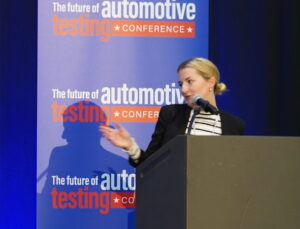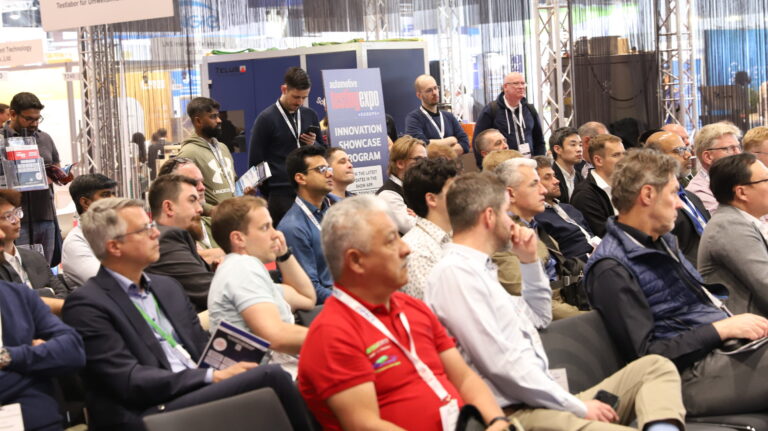The doors to this year’s Automotive Testing Expo North America open next week, bringing together the global automotive testing community for three days of knowledge-sharing, discovery and connection on October 21-23. Recognized as the must-attend event for professionals across vehicle development, validation and quality assurance, the show offers an unmatched opportunity to gather intelligence, explore cutting-edge technologies and engage with thought leaders shaping the future of automotive testing
Among the highlights this year are The Future of Automotive Testing Conference (October 22), where experts will discuss the latest strategies, tools and challenges in the evolving testing landscape, and the Innovation Showcase, spotlighting the most advanced solutions and technologies transforming the industry.
With years of experience covering the evolution of automotive testing, Automotive Testing Technology International editor Rachel Evans shares which sessions she’s most looking forward to at the conference, the technologies reshaping conventional testing and validation workflows, and what makes a successful test strategy.
What’s your role in this year’s conference?
My main involvement in the conference will be an onstage interview with ATTI‘s regular columnist, Jon M Quigley. Jon has a wealth of experience within vehicle testing and has worked with OEMs both in-house and as a consultant providing services through his business, Value Transformation. We will be discussing transparency in testing. Jon will share examples from his career when transparency was lacking and what the impact was, his thoughts on reporting structures, tools and processes that can be used to support better communication, and much more.
What challenges is the automotive test and development industry in North America currently facing?
Although they do not directly influence testing, the tariffs earlier this year threw a spanner in the works for everybody, causing a ripple down effect – and we recognize the additional pressure the tariffs have placed on the whole sector.
How has the landscape changed in the USA, or globally, while you’ve been ATTI editor?
One clear trend we’ve seen globally in the last 2-5 years is a sharp increase in the uptake of simulation, and the integration of virtual and physical testing when these two components used to be very separate. That said, within the simulation sphere, there is still fragmentation in processes, so that’s one area I’m keen to see evolve.
Automation and remote monitoring are being used more heavily in various areas, with new capabilities being introduced by suppliers – and it’ll be interesting to hear how developers are getting to grips with these new capabilities.
Another notable trend is the development of resources that bring evaluation traditionally done on roads into the lab. Primary examples are DNW’s Automotive Test Section, which enables WLTP coastdown testing for large vehicles in the wind tunnel; Arctic Falls’ Indoor 3 for automotive and tire analysis; and Mercedes-Benz’s new light testing tunnel. These facilities streamline testing by simulating hard-to-find geographical features and conditions in a controlled and flexible environment.
 Which conference sessions are you particularly looking forward to?
Which conference sessions are you particularly looking forward to?
The presentation from Stoyan Nikolov at Bosch – The future of automotive testing: integrated, predictive and scalable to millions of cases – has caught my eye. Stoyan will address the need for embedded testing throughout development, specifically how embedding scalable, intelligent, data-driven testing directly into the development lifecycle can be achieved. While developers are well aware that a move away from traditional downstream testing is necessary, making the transition is a tough, intricate task.
What trends and products should visitors look out for this year?
I think now more than ever, developers have an open mindset when it comes to testing processes and tools – they are willing and ready to try new things. For example, ZF Test Systems’ new Road Belt Tester force and moment rig is rewriting what’s possible in terms of vehicle performance simulation and has been extremely well received by companies across the world. The machine is also another example of how developers are increasing their use of simulation.
And WOM’s Wheel Orientation Measurement device that was built from scratch to capture tire data in real-world settings, and which overcomes common difficulties in on-vehicle tire characterization – this too takes an entirely fresh approach to a testing task that’s always been done a certain way.
What is your view on future testing best practices and the increasing pressures of decision-making in high-stakes environments?
Generally I’d say that in today’s data-driven environment, the most successful test strategies should integrate automation, digitalization and collaboration.
Hear from Rachel on October 22 at The Future of Automotive Testing Conference, where she will be joined by engineering experts and thought leaders from Ford, Stellantis, Bosch, Tata Technologies, and Goodyear, among others.
Automotive Testing Expo North America website will take place at the Suburban Collection Showplace in Novi, Michigan, on October 22-23. Visit the expo website to register for your free expo pass.


